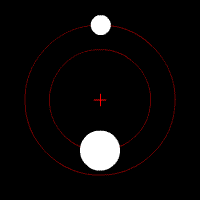Gravitational two-body problem
The gravitational two-body problem concerns the motion of two point particles that interact only with each other, due to gravity. This means that influences from any third body are neglected. For approximate results that is often suitable. It also means that the two bodies stay clear of each other, that is, the two do not collide, and one body does not pass through the other's atmosphere. Even if they do, the theory still holds for the part of the orbit where they don't. Apart from these considerations a spherically symmetric body can be approximated by a point mass.
- For further relevant mathematical developments see also Two-body problem, Kepler orbit, Kepler problem, and Equation of the center.
Common examples include the parts of a spaceflight where the spacecraft is not undergoing propulsion and atmospheric effects are negligible, and a single celestial body overwhelmingly dominates the gravitational influence. Other common examples are the orbit of a moon around a planet, and of a planet around a star, and two stars orbiting each other (a binary star).
Solution
The reduced mass multiplied by the relative acceleration between the two bodies is equal to the gravitational force. The latter is proportional to the product of the two masses, which is equal to the reduced mass divided by the sum of the masses. Thus in the differential equation the two occurrences of the reduced mass cancel each other, and we get the same differential equation as for the position of a very small body orbiting a body with a mass equal to the sum of the two masses.

- Assume:
- the vector r is the position of one body relative to the other
- , , the semi-major axis , and the specific relative angular momentum are defined accordingly (hence is the distance)
- is the total angular momentum divided by the reduced mass
- , the standard gravitational parameter (the sum of those for each mass)[1]
- where:
- and are the masses of the two bodies.
- Then:
- the general solution is (see also the orbit equation and two-body problem for an inverse-square force):
- for any non-negative , called the eccentricity; here is the true anomaly, which is the angle between the current position of the orbiting object and the location in the orbit at which it is closest to the central body (called the periapsis).
- the positions of the bodies with respect to the barycenter are and times r, respectively, so the two bodies' orbits are similar conic sections; the same ratios apply for the velocities, and, without the minus, for the angular momentum and for the kinetic energies, all with respect to the barycenter
- for circular orbits
- for elliptic orbits: (with a expressed in AU and T in years, and with M the total mass relative to that of the Sun, we get )
- for parabolic trajectories is constant and equal to
- the formulas for the specific orbital energy apply, with specific potential and kinetic energy and their sum taken as the totals for the system, divided by the reduced mass; the kinetic energy of the smaller body is larger; the potential energy of the whole system is equal to the potential energy of one body with respect to the other, i.e. minus the energy needed to escape the other if the other is kept in a fixed position; this should not be confused with the smaller amount of energy one body needs to escape, if the other body moves away also, in the opposite direction: in that case the total energy the two need to escape each other is the same as the aforementioned amount; the conservation of energy for each mass means that an increase of kinetic energy is accompanied by a decrease of potential energy, which is for each mass the inner product of the force and the change in position relative to the barycenter, not relative to the other mass
- for elliptic and hyperbolic orbits
- For example, consider two bodies like the Sun orbiting each other:
- the reduced mass is one half of the mass of one Sun (one quarter of the total mass)
- at a distance of 1 AU: the orbital period is year, the same as the orbital period of the Earth would be if the Sun had twice its actual mass; the total energy per kg reduced mass (90 MJ/kg) is twice that of the Earth–Sun system (45 MJ/kg); the total energy per kg total mass (22.5 MJ/kg) is one half of the total energy per kg Earth mass in the Earth–Sun system (45 MJ/kg)
- at a distance of 2 AU (each following an orbit like that of the Earth around the Sun): the orbital period is 2 years, the same as the orbital period of the Earth would be if the Sun would have one quarter of its actual mass
- at a distance of AU: the orbital period is 1 year, the same as the orbital period of the Earth around the Sun
- Similarly, a second Earth at a distance from the Earth equal to times the usual distance of geosynchronous orbits would be geosynchronous.
Examples
Any classical system of two particles is, by definition, a two-body problem. In many cases, however, one particle is significantly heavier than the other, e.g., the Earth and the Sun. In such cases, the heavier particle is approximately the center of mass, and the reduced mass is approximately the lighter mass. Hence, the heavier mass may be treated roughly as a fixed center of force, and the motion of the lighter mass may be solved for directly by one-body methods.
In other cases, however, the masses of the two bodies are roughly equal, so that neither of them can be approximated as being at rest. Astronomical examples include:
- a binary star, e.g. Alpha Centauri (approx. the same mass)
- a double planet, e.g. Pluto with its moon Charon (mass ratio 0.147)
- a binary asteroid, e.g. 90 Antiope (approx. the same mass)
See also
Notes
- Note that the μ is not the reduced mass on this page.
